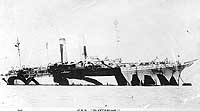
S.S. City of New York, a 10,499 gross ton passenger steamer, was built at Glasgow, Scotland, in 1888. A sister of the S.S. City of Paris, and of equally striking appearance with three smokestacks and a "clipper" bow, she operated between the United Kingdom and the United States under the British merchant flag until 1893, when she was transferred to U.S. registry and renamed New York. Her commercial activities remained as before until April 1898, when she was chartered by the U.S. Navy for Spanish-American War service. Converted to an auxiliary cruiser and renamed Harvard, she was placed in commission in late April and served thereafter on scouting duties in the Caribbean and as a transport. During the 3 July 1898 naval battle off Santiago, Cuba, she rescued more than 600 survivors of wrecked Spanish warships. After carrying U.S. troops home from Cuba, Harvard was decommissioned in September 1898 and returned to her owners.
Resuming the name New York, she spent nearly two decades more in the U.S. merchant marine. In 1901-1903 the ship was rebuilt, emerging with two tall smokestacks and new engines. On 9 April 1917, a few days after the United States entered World War I, New York was approaching Liverpool, England, when she struck a German mine. Following repairs, she was employed under Army charter to take U.S. troops to the European war zone.
In May 1918 New York was taken over by the U.S. Navy
for continued employment as a troop
transport. Commissioned later in that month as the 15,390
ton (displacement) USS Plattsburg (ID # 1645), she made
four voyages to France, carrying nearly 9,000 servicemen, before
the 11 November 1918 Armistice brought the First World War's fighting
to an end. The ship then began transporting American forces home,
making seven more trips with more than 24,000 passengers by the
end of August 1919. Decommissioned in October of that year, she
subsequently returned to merchant service as S.S. New York.
Between 1920 and 1922 the now quite elderly liner went through
a series of owners, none of whom succeeded commercially. She was
scrapped at Genoa, Italy, in 1923.
This page features, and provides links to, all the views we have concerning USS Plattsburg (ID # 1645), USS Harvard (1898) and the civilian passenger ship City of New York and New York of 1888.
For more images related to this ship, see:
| If you want higher resolution reproductions than the digital images presented here, see: "How to Obtain Photographic Reproductions." |
Click on the small photograph to prompt a larger view of the same image.
|
Photo #: NH 42619 S.S. New York (American Passenger Liner, 1888) Painted in Mackay "low visibility" camouflage, while operating as a transport in 1917. She later became USS Plattsburg (ID # 1645). Courtesy of International Mercantile Marine Company, New York. U.S. Naval History and Heritage Command Photograph. Online Image: 79KB; 740 x 555 pixels |
 |
|
Photo #: NH 77168 S.S. New York (American Passenger Liner, 1888) Steaming through the war zone while operating as a troop transport in 1917 or early 1918. Photographed from on board USS Warrington (Destroyer # 30), which was escorting the transport as she approached the end of a trans-Atlantic voyage from the United States. Courtesy of Gustavus C. Robbins, 1973. U.S. Naval History and Heritage Command Photograph. Online Image: 63KB; 740 x 535 pixels |
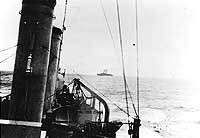 |
|
Photo #: NH 45136 S.S. New York (American Passenger Liner, 1888) In drydock at Liverpool, England, on 12 April 1917, showing mine damage received on 9 April, while she was approaching Liverpool at the end of a trans-Atlantic trip. Among the ship's passengers on this voyage was Rear Admiral William S. Sims, USN, who was assigned to the British Admiralty as the U.S. Navy's representative. Note the large hole in New York's hull side below the waterline, the U.S. flag neutrality marking (the United States had entered World War I after the ship began this trip), and her forward port side deck gun. Photographed by H. Dowden. U.S. Naval History and Heritage Command Photograph. Online Image: 80KB; 525 x 765 pixels |
 |
|
Photo #: NH 45137 S.S. New York (American Passenger Liner, 1888) Mine damage to the ship's port side, forward, received on 9 April 1917, while she was approaching Liverpool, England, at the end of a trans-Atlantic trip. Photographed by H. Dowden on 12 April, while New York was in drydock at Liverpool. The view looks aft from the dock's floor. U.S. Naval History and Heritage Command Photograph. Online Image: 73KB; 510 x 765 pixels |
 |
|
Photo #: NH 43047 USS Plattsburg (ID # 1645) At the New York Navy Yard on 7 June 1918, shortly before her first trans-Atlantic voyage as a U.S. Navy ship. She has been freshly painted in pattern camouflage. U.S. Naval History and Heritage Command Photograph. Online Image: 87KB; 740 x 595 pixels |
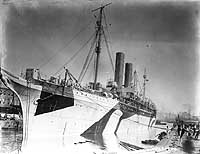 |
|
Photo #: NH 103078 USS Plattsburg (ID # 1645) Tied to a mooring buoy, circa 1918, while wearing pattern camouflage. The original image is printed on postal card ("AZO") stock. Donation of Dr. Mark Kulikowski, 2005. U.S. Naval History and Heritage Command Photograph. Online Image: 56KB; 740 x 435 pixels |
 |
|
Photo #: NH 42410 USS Plattsburg (ID # 1645) At Brest, France, 23 September 1918. Built in 1888 as the passenger liner City of New York and later renamed New York, this ship briefly served as USS Harvard between 26 April and 2 September 1898. On 9 May 1918, following employment as a civilian-operated troop transport, S.S. New York was chartered by the Navy and, on 24 May 1918, placed in commission as USS Plattsburg. She was returned to her owners on 6 October 1919. U.S. Naval History and Heritage Command Photograph. Online Image: 98KB; 740 x 540 pixels |
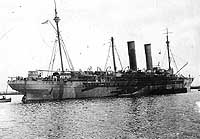 |
|
Photo #: NH 106050 USS Plattsburg (ID # 1645) Halftone reproduction of a photograph of the ship in a harbor, 1919. This view was published in 1919 as one of ten images in a "Souvenir Folder" concerning USS Plattsburg. Donation of Dr. Mark Kulikowski, 2008. U.S. Naval History and Heritage Command Photograph. Online Image: 64KB; 740 x 505 pixels |
 |
|
Photo #: NH 107027 USS Plattsburg (ID # 1645) In drydock, 1919. The original image is printed on a post card mailed in May 1919. Donation of Dr. Mark Kulikowski, 2010. U.S. Naval History and Heritage Command Photograph. Online Image: 105KB; 900 x 570 pixels |
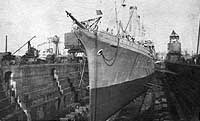 |
|
Photo #: NH 82951 "The Original U.S. Troop Transports" Chart compiled 16 August 1919, showing the number of trans-Atlantic "turn arounds" and their average duration for thirty seven U.S. Navy troop transports employed during and immediately after World War I. Collection of the USS Pocahontas Reunion Association, 1974. U.S. Naval History and Heritage Command Photograph. Online Image: 157KB; 690 x 655 pixels Click here to rotate chart 90 degrees clockwise |
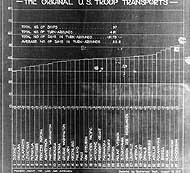 |
For more images related to this ship, see:
NOTES:
| If you want higher resolution reproductions than the digital images presented here, see: "How to Obtain Photographic Reproductions." |
Page made 30 January 2006
New image added 12 June 2010